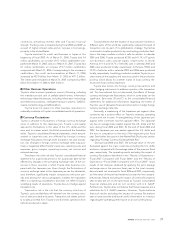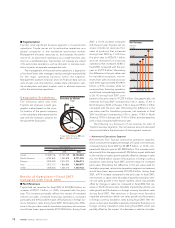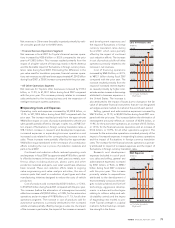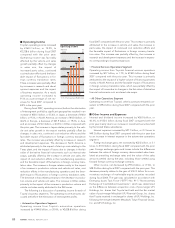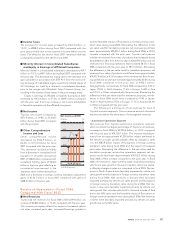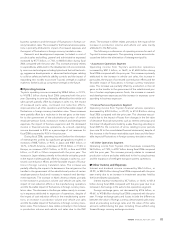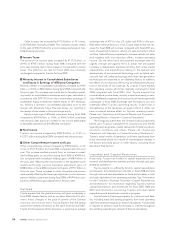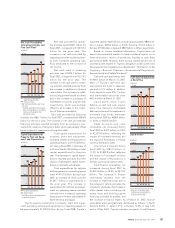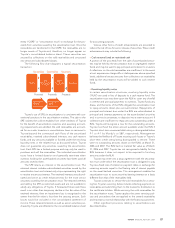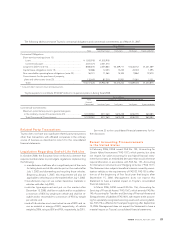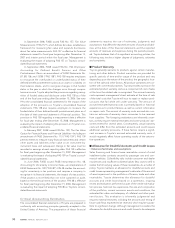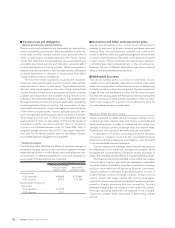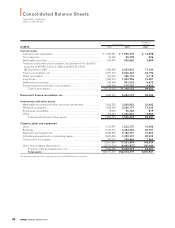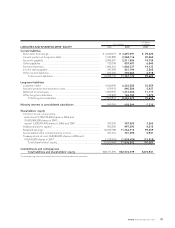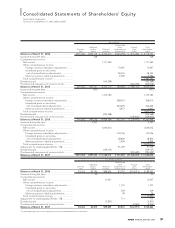Toyota 2007 Annual Report Download - page 89
Download and view the complete annual report
Please find page 89 of the 2007 Toyota annual report below. You can navigate through the pages in the report by either clicking on the pages listed below, or by using the keyword search tool below to find specific information within the annual report.
ANNUAL REPORT 2007 87
entity (“QSPE” or “securitization trust”) in exchange for the pro-
ceeds from securities issued by the securitization trust. Once the
receivables are transferred to the QSPE, the receivables are no
longer assets of Toyota and, therefore, no longer appear on
Toyota’s consolidated balance sheet. These securities are
secured by collections on the sold receivables and structured
into senior and subordinated classes.
The following flow chart diagrams a typical securitization
transaction:
Toyota’s use of SPEs in securitizations is consistent with con-
ventional practices in the securitization markets. The sale to the
SPE isolates the sold receivables from other creditors of Toyota
for the benefit of securitization investors and, assuming account-
ing requirements are satisfied, the sold receivables are account-
ed for as a sale. Investors in securitizations have no recourse to
Toyota beyond the contractual cash flows of the securitized
receivables, retained subordinated interests, any cash reserve
funds, and any amounts available or funded under the revolving
liquidity notes in the related trust as discussed below. Toyota
does not guarantee any securities issued by the securitization
trust. Each SPE has a limited purpose and may only be used to
purchase and sell the receivables. The individual securitization
trusts have a limited duration and generally terminate when
investors holding the asset-backed securities have been paid all
amounts owed to them.
The SPE retains an interest in the securitization trust. The
retained interest includes subordinated securities issued by the
securitization trust and interest-only strips representing the right
to receive any excess interest. The retained interests are subordi-
nated and serve as credit enhancements for the more senior
securities issued by the securitization trust. The retained interests
are held by the SPE as restricted assets and are not available to
satisfy any obligations of Toyota. If forecasted future cash flows
result in an other-than-temporary decline in the fair value of the
retained interests, then an impairment loss is recognized to the
extent that the fair value is less than the carrying amount. Such
losses would be included in the consolidated statement of
income. These retained interests as well as senior securities pur-
chased by Toyota are reflected in the consolidated balance sheet
for accounting purposes.
Various other forms of credit enhancements are provided to
reduce the risk of loss for senior classes of securities. These credit
enhancements may include the following:
• Cash reserve funds or restricted cash
A portion of the proceeds from the sale of asset-backed securi-
ties may be held by the securitization trust in segregated reserve
funds and may be used to pay principal and interest to investors
if collections on the sold receivables are insufficient. In the event
a trust experiences charge-offs or delinquencies above specified
levels, additional excess amounts from collections on receivables
held by the securitization trusts will be added to such reserve
funds.
• Revolving liquidity notes
In certain securitization structures, revolving liquidity notes
(“RLN”) are used in lieu of deposits to a cash reserve fund. The
securitization trust may draw upon the RLN to cover any shortfall
in interest and principal payments to investors. Toyota funds any
draws, and the terms of the RLN obligate the securitization trust
to repay amounts drawn plus accrued interest. Repayments of
principal and interest due under the RLN are subordinated to
principal and interest payments on the asset-backed securities
and, in some circumstances, to deposits into a reserve account. If
collections are insufficient to repay amounts outstanding under a
RLN, Toyota will recognize a loss for the outstanding amounts.
Toyota must fund the entire amount available under the RLN if
Toyota’s short-term unsecured debt rating is downgraded below
P-1 or A-1 by Moody’s or S&P, respectively. Management
believes the likelihood of Toyota incurring such losses or Toyota’s
short-term credit rating being downgraded is remote. There
were no outstanding amounts drawn on the RLN’s at March 31,
2006 and 2007. The RLN had no material fair value as of March
31, 2006 and 2007. Toyota has not recognized a liability for the
RLN because it does not expect to be required to fund any
amounts under the RLN.
Toyota may enter into a swap agreement with the securitiza-
tion trust under which the securitization trust is obligated to pay
Toyota a fixed rate of interest on payment dates in exchange for
receiving amounts equal to the floating rate of interest payable
on the asset backed securities. This arrangement enables the
securitization trust to issue securities bearing interest on a basis
different from that of the receivables held.
Toyota continues to service the sold receivables for a servic-
ing fee. Toyota’s servicing duties include collecting payments on
receivables and submitting them to the trustee for distribution to
the certificate holders. While servicing the sold receivables for
the securitization trusts, Toyota applies the same servicing poli-
cies and procedures that are applied to the owned receivables
and maintains a normal relationship with the financing customers.
Other significant provisions relating to securitizations are
described below.
Off-balance
sheet
transaction
Toyota SPE
(Wholly-owned
by Toyota)
Investors
QSPE
(Securitization
Trust)
Receivables Receivables Securities
Proceeds Proceeds Proceeds
Bankruptcy
remote
transaction


